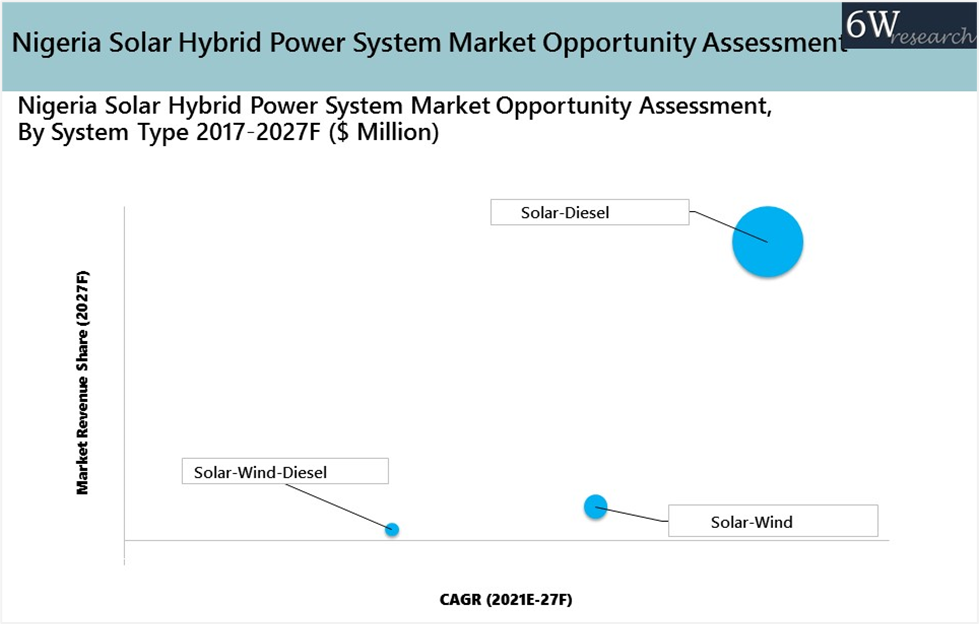Nigeria Solar Hybrid Power System Market Outlook (2021-2027) | Trends, Share, COVID-19 IMPACT, Industry, Forecast, Growth, Size, Revenue, Companies, Analysis & Value
By System Types (Solar-Diesel, Solar-Wind, Solar-Wind-Diesel),By Power Ratings (Upto 10kW, 10.1-100kW, Above 100kW),By End Users (Residential, Commercial, Telecom, Utility, Industrial),By Regions (North-Eastern Region, North-Western Region, Central RegionSouth-Eastern Region, South-Western Region)
| Product Code: ETC150356 | Publication Date: Jan 2022 | Updated Date: Aug 2025 | Product Type: Report | |
| Publisher: 6Wresearch | No. of Pages: 90 | No. of Figures: 23 | No. of Tables: 6 | |
Nigeria Solar Hybrid Power System Market Size & Growth Rate
The Nigeria Solar Hybrid Power System Market is projected to grow at a CAGR of 9.6% during 2021–2027, driven by inadequate grid infrastructure, government-led rural electrification initiatives, and the growing shift toward cleaner and more reliable energy solutions to meet the country’s rising power demand.
Nigeria Solar Hybrid Power System Market report thoroughly covers market by system types, power ratings, end users, regions. The market report provides an unbiased and detailed analysis of the on-going market trends, opportunities/high growth areas and market drivers which would help the stakeholders to devise and align their market strategies according to the current and future market dynamics.
Nigeria Solar Hybrid Power System Market Synopsis
Nigeria solar hybrid power system market grew significantly during 2017 to 2019 on the back of Nigeria inadequate grid infrastructure due to which there was a lack of adequate power supply that resulted in over $25 billion annual losses to Nigeria’s economy, which is approximately 6% of its GDP. Therefore, Nigeria needs to install solar hybrid power system as the backup supply option or primary source to address the power requirements. In year 2020, Nigeria’s maximum available capacity on the grid is 5.4GW per annum whereas consumption needs were averaging 12.9 GW per annum, and this gap of capacity and demand would drive the market of solar hybrid systems in Nigeria.
 Nigeria solar hybrid power system market witnessed modest decline in 2020 on the back of COVID 19 pandemic as Nigeria solar hybrid power system market is import driven, pandemic resulted in slowdown of product’s growth due to the disrupted supply chain, causing unavailability of raw materials owing to lockdown measures adopted to curb the spread of the virus, which in turn led to a decline in revenues of the product during pandemic. Although, with the gradual upliftment of lockdown restrictions, sales of solar hybrid power system begun to get back on track as operations and production resumed, which led market back to its growth trajectory.
Nigeria solar hybrid power system market witnessed modest decline in 2020 on the back of COVID 19 pandemic as Nigeria solar hybrid power system market is import driven, pandemic resulted in slowdown of product’s growth due to the disrupted supply chain, causing unavailability of raw materials owing to lockdown measures adopted to curb the spread of the virus, which in turn led to a decline in revenues of the product during pandemic. Although, with the gradual upliftment of lockdown restrictions, sales of solar hybrid power system begun to get back on track as operations and production resumed, which led market back to its growth trajectory.
According to 6Wresearch, Nigeria Solar Hybrid Power System Market revenue size is projected to grow at a CAGR of 9.6% during 2021-2027. The demand for solar hybrid power system increased on account of government initiative to increase electrification in the country such as Rural Electrification Agency plans to install 10,000 mini grids by 2023 and set up hybrid solar projects for seven universities in Nigeria. Additionally, to support Nigeria’s climate change obligations under the Paris Agreement, with respect to promoting renewable and reducing carbon emissions, is driving the solar hybrid power system market in country.

Market by System Types Analysis
In terms of system types, solar-diesel hybrid power system has captured 84.3% of the market revenue in 2020. solar-diesel hybrid power systems accounted for the major market revenue share in 2020 owing to Nigeria’s high PV output power and easy availability of diesel whereas wind energy is not much viable in Nigeria. Furthermore, diesel generator high operation cost and pollution caused by it are driving the consumers to shift towards the cleaner and greener energy source such as solar hybrid power systems who have lower operational cost.

Market by End Users Analysis
In terms of end users, commercial segment has captured 41.2% of the market revenue share in 2020. Commercial and industrial segment accounted for maximum market revenue share as these verticals face high energy costs due to the use of diesel generators as an emergency power supply to compensate for supply shortages. Off-grid solar hybrid power systems provide low-cost and serve as a clean alternative for the commercial and industrial sectors to meet their energy requirements.
Key Attractiveness of the Report
- COVID-19 Impact on the Market.
- 10 Years Market Numbers.
- Historical Data Starting from 2017 to 2020.
- Base Year: 2020
- Forecast Data until 2027.
- Key Performance Indicators Impacting the Market.
- Major Upcoming Developments and Projects.
Key Highlights of the Report:
- Nigeria Solar Hybrid Power System Market Overview
- Nigeria Solar Hybrid Power System Market Outlook
- Nigeria Solar Hybrid Power System Market Forecast
- Historical Data and Forecast of Nigeria Solar Hybrid Power System Market Revenues, for the Period 2017-2027F.
- Historical Market Data and Forecast of Nigeria Solar Hybrid Power System Market Revenues, By System Types, for the Period 2017-2027F.
- Historical Market Data and Forecast of Nigeria Solar Hybrid Power System Market Revenues, By Power Ratings, for the Period 2017-2027F.
- Historical Market Data and Forecast of Nigeria Solar Hybrid Power System Market Revenues, By End Users, for the Period 2017-2027F.
- Historical Market Data and Forecast of Nigeria Solar Hybrid Power System Market Revenues, By Regions, for the Period 2017-2027F.
- Market Drivers and Restraints
- Market Trends and Evolution
- Industry Life Cycle
- Porter’s Five Force Analysis
- Market Opportunity Assessment
- Nigeria Solar Hybrid Power System Market Ranking, By Companies
- Competitive Benchmarking
- Company Profiles
- Key Strategic Recommendations
Market Scope and Segmentation
The report provides a detailed analysis of the following market segments:
- By System Types
- Solar-Diesel
- Solar-Wind
- Solar-Wind-Diesel
- By Power Ratings
- Upto 10kW
- 1-100kW
- Above 100kW
- By End Users
- Residential
- Commercial
- Telecom
- Utility
- Industrial
- By Regions
- North-Eastern Region
- North-Western Region
- Central Region
- South-Eastern Region
- South-Western Region
Nigeria Solar Hybrid Power System Market: FAQs
| 1. Executive Summary |
| 2. Introduction |
| 2.1 Report Description |
| 2.2 Key Highlights |
| 2.3 Market Scope & Segmentation |
| 2.4 Research Methodology |
| 2.5 Assumptions |
| 3. Nigeria Solar Hybrid Power System Market Overview |
| 3.1 Nigeria Solar Hybrid Power System Market Revenues, 2017-2027F |
| 3.2 Nigeria Solar Hybrid Power System Market Industry Life Cycle |
| 3.3 Nigeria Solar Hybrid Power System Market Porter’s Five Forces Model |
| 3.4 Impact Analysis of COVID-19 on Nigeria Solar Hybrid Power System Market |
| 3.5 Nigeria Solar Hybrid Power System Market Revenue Share, By System Types, 2020 & 2027F |
| 3.6 Nigeria Solar Hybrid Power System Market Revenue Share, By Power Ratings, 2020 & 2027F |
| 3.7 Nigeria Solar Hybrid Power System Market Revenue Share, By End Users, 2020 & 2027F |
| 3.8 Nigeria Solar Hybrid Power System Market Revenue Share, By Regions, 2020 & 2027F |
| 4. Nigeria Solar Hybrid Power System Market Dynamics |
| 4.1 Impact Analysis |
| 4.2 Market Drivers |
| 4.2.1 Increasing awareness and adoption of renewable energy sources in Nigeria |
| 4.2.2 Government incentives and initiatives to promote solar energy solutions |
| 4.2.3 Rise in demand for reliable and sustainable power sources in off-grid and remote areas |
| 4.3 Market Restraints |
| 4.3.1 High initial installation costs for solar hybrid power systems |
| 4.3.2 Lack of skilled workforce for maintenance and installation of solar systems |
| 4.3.3 Limited access to financing options for consumers and businesses |
| 5. Nigeria Solar Hybrid Power System Market Trends |
| 6. Nigeria Solar Hybrid Power System Market Overview, By System Types |
| 6.1 Nigeria Solar Hybrid Power System Market Revenues, By Solar Diesel, 2017-2027F |
| 6.2 Nigeria Solar Hybrid Power System Market Revenues, By Solar Wind, 2017-2027F |
| 6.3 Nigeria Solar Hybrid Power System Market Revenues, By Solar Wind Diesel, 2017-2027F |
| 7. Nigeria Solar Hybrid Power System Market Overview, By Power Ratings |
| 7.1 Nigeria Solar Hybrid Power System Market Revenues, By Upto 10kW, 2017-2027F |
| 7.2 Nigeria Solar Hybrid Power System Market Revenues, By 10.1-100kW, 2017-2027F |
| 7.3 Nigeria Solar Hybrid Power System Market Revenues, By Above 100kW, 2017-2027F |
| 8. Nigeria Solar Hybrid Power System Market Overview, By End Users |
| 8.1 Nigeria Solar Hybrid Power System Market Revenues, By Residential, 2017-2027F |
| 8.2 Nigeria Solar Hybrid Power System Market Revenues, By Commercial, 2017-2027F |
| 8.3 Nigeria Solar Hybrid Power System Market Revenues, By Telecom, 2017-2027F |
| 8.4 Nigeria Solar Hybrid Power System Market Revenues, By Utility, 2017-2027F |
| 8.5 Nigeria Solar Hybrid Power System Market Revenues, By Industrial, 2017-2027F |
| 8.6 Nigeria Solar Hybrid Power System Market Revenues, By Others, 2017-2027F |
| 9. Nigeria Solar Hybrid Power System Market Overview, By Regions |
| 9.1 Nigeria Solar Hybrid Power System Market Revenues, By North-Eastern Region, 2017-2027F |
| 9.2 Nigeria Solar Hybrid Power System Market Revenues, By North-Western Region, 2017-2027F |
| 9.3 Nigeria Solar Hybrid Power System Market Revenues, By Central Region, 2017-2027F |
| 9.4 Nigeria Solar Hybrid Power System Market Revenues, By South-Eastern Region, 2017-2027F |
| 9.5 Nigeria Solar Hybrid Power System Market Revenues, By South-Western Region, 2017-2027F |
| 10. Nigeria Solar Hybrid Power System Market Key Performance Indicators |
| 10.1 Average cost per watt of solar hybrid power systems |
| 10.2 Number of government policies supporting renewable energy adoption |
| 10.3 Growth rate of off-grid solar installations |
| 10.4 Percentage of households or businesses switching to solar energy |
| 10.5 Number of training programs for solar system maintenance and installation |
| 11. Nigeria Solar Hybrid Power System Market Opportunity Assessment |
| 11.1 Nigeria Solar Hybrid Power System Market Opportunity Assessment, By System Types, 2027F |
| 11.2 Nigeria Solar Hybrid Power System Market Opportunity Assessment, By End Users, 2027F |
| 11.3 Nigeria Solar Hybrid Power System Market Opportunity Assessment, By Power Ratings, 2027F |
| 11.4 Nigeria Solar Hybrid Power System Market Opportunity Assessment, By Regions, 2027F |
| 12. Nigeria Solar Hybrid Power System Market Competitive Landscape |
| 12.1 Nigeria Solar Hybrid Power System Market Revenue Share Ranking, By Companies, 2020 |
| 12.2 Nigeria Solar Hybrid Power System Market Competitive Benchmarking, By Technical Parameters |
| 12.3 Nigeria Solar Hybrid Power System Market Competitive Benchmarking, By Operating Parameters |
| 13. Company Profiles |
| 13.1 ZTE Nigeria Limited |
| 13.2 Huawei Technologies Company (Nigeria) Limited |
| 13.3 SMA Solar Technology AG |
| 13.4 Siemens AG |
| 13.5 Flexenclosure AB |
| 13.6 Husk Power Systems, Inc. |
| 13.7 Sunhive Ltd. |
| 13.8 Havenhill Synergy Limited |
| 13.9 Rubitec Nigeria Ltd. |
| 13.10 Starsight Power Utility Ltd. |
| 13.11 Daystar Power Solutions Ltd. |
| 13.12 Victron Energy B.V. |
| 14. Key Strategic Recommendations |
| 15. Disclaimer |
| List of Figures |
| Figure 1. Nigeria Solar Hybrid Power System Market Revenues and Volume, 2017-2027F ($ Million) |
| Figure 2. Nigeria Solar Hybrid Power System Market Revenue Share, By System Types, 2020 & 2027F |
| Figure 3. Nigeria Solar Hybrid Power System Market Revenue Share, By Power Rating, 2020 & 2027F |
| Figure 4. Nigeria Solar Hybrid Power System Market Revenue Share, By End Users , 2020 & 2027F |
| Figure 5. Nigeria Solar Hybrid Power System Market Revenue Share, By Regions, 2020 & 2027F |
| Figure 6. Access to Electricity to Nigeria’s Population, 2013-2019 (% of population) |
| Figure 7. Nigeria’s population connectivity to national grid, 2020 (% of population) |
| Figure 8. Nigeria’s Percentage of different grids, 2020 (%) |
| Figure 9. Nigeria’s Industrial Sector (including construction) GDP share, 2013-2020 (% of total) |
| Figure 10. Nigeria contribution of Telecom industry to GDP, Q1 2019- Q2 2021 (%) |
| Figure 11. Nigeria Manufacturing Sector, 2017-2020 (%) |
| Figure 12. Nigeria’s Mining and Quarrying Sector, Q4 2019-Q1 2020 (%) |
| Figure 13. Nigeria’s Metal Ores, 2017-2020 (%) |
| Figure 14. Nigeria’s Hotel Room Revenue, 2016-2021E (% of Total) |
| Figure 15. Available Rooms in Nigeria, 2016-2021E (Thousands) |
| Figure 16. Nigeria’s Contribution of Oil and Gas Sector to GDP, 2019-2021 (% of total) |
| Figure 17. Nigeria’s Contraction of Oil Refining, Q1 2019-Q42020 (%) |
| Figure 18. Nigeria Solar Hybrid Power System Market Opportunity Assessment, By System Types, 2027F |
| Figure 19. Nigeria Industrial Solar Hybrid Power System Market Opportunity Assessment, By Power Ratings, 2027F |
| Figure 20. Nigeria Industrial Solar Hybrid Power System Market Opportunity Assessment, By End Users, 2027F |
| Figure 21. Nigeria Industrial Solar Hybrid Power System Market Opportunity Assessment, By Regions, 2027F |
| Figure 22. Nigeria Solar Hybrid Power System Market Volume Share, By Companies, 2020 |
| Figure 23. Nigeria Solar Hybrid Power System Market Future Opportunities |
| List of Tables |
| Table 1. Nigeria Major Ongoing Construction Projects, 2022-2023 |
| Table 2. Nigeria Solar Hybrid Power System Market Revenues, By System Types, 2017-2027F ($ Million) |
| Table 3. Nigeria Solar Hybrid Power System Market Revenues, By Power Ratings, 2017-2027F ($ Million) |
| Table 4. Nigeria Solar Hybrid Power System Market Revenues, By End Users, 2017-2027F ($ Million) |
| Table 5. Nigeria Solar Hybrid Power System Market Revenues, By Regions, 2017-2027F ($ Million) |
| Table 6. Nigeria Solar Hybrid Power Projects Commissioned in South-West and Central Region |
- Single User License$ 1,995
- Department License$ 2,400
- Site License$ 3,120
- Global License$ 3,795
Search
Related Reports
- ASEAN Bearings Market (2025-2031) | Strategy, Consumer Insights, Analysis, Investment Trends, Opportunities, Growth, Size, Share, Industry, Revenue, Segments, Value, Segmentation, Supply, Forecast, Restraints, Outlook, Competition, Drivers, Trends, Demand, Pricing Analysis, Competitive, Strategic Insights, Companies, Challenges
- Europe Flooring Market (2025-2031) | Outlook, Share, Industry, Trends, Forecast, Companies, Revenue, Size, Analysis, Growth & Value
- Saudi Arabia Manlift Market (2025-2031) | Outlook, Size, Growth, Trends, Companies, Industry, Revenue, Value, Share, Forecast & Analysis
- Uganda Excavator, Crane, and Wheel Loaders Market (2025-2031) | Strategy, Consumer Insights, Analysis, Investment Trends, Opportunities, Growth, Size, Share, Industry, Revenue, Segments, Value, Segmentation, Supply, Forecast, Restraints, Outlook, Competition, Drivers, Trends, Demand, Pricing Analysis, Competitive, Strategic Insights, Companies, Challenges
- Rwanda Excavator, Crane, and Wheel Loaders Market (2025-2031) | Strategy, Consumer Insights, Analysis, Investment Trends, Opportunities, Growth, Size, Share, Industry, Revenue, Segments, Value, Segmentation, Supply, Forecast, Restraints, Outlook, Competition, Drivers, Trends, Demand, Pricing Analysis, Competitive, Strategic Insights, Companies, Challenges
- Kenya Excavator, Crane, and Wheel Loaders Market (2025-2031) | Strategy, Consumer Insights, Analysis, Investment Trends, Opportunities, Growth, Size, Share, Industry, Revenue, Segments, Value, Segmentation, Supply, Forecast, Restraints, Outlook, Competition, Drivers, Trends, Demand, Pricing Analysis, Competitive, Strategic Insights, Companies, Challenges
- Angola Excavator, Crane, and Wheel Loaders Market (2025-2031) | Strategy, Consumer Insights, Analysis, Investment Trends, Opportunities, Growth, Size, Share, Industry, Revenue, Segments, Value, Segmentation, Supply, Forecast, Restraints, Outlook, Competition, Drivers, Trends, Demand, Pricing Analysis, Competitive, Strategic Insights, Companies, Challenges
- Israel Intelligent Transport System Market (2025-2031) | Strategy, Consumer Insights, Analysis, Investment Trends, Opportunities, Growth, Size, Share, Industry, Revenue, Segments, Value, Segmentation, Supply, Forecast, Restraints, Outlook, Competition, Drivers, Trends, Demand, Pricing Analysis, Competitive, Strategic Insights, Companies, Challenges
- Uganda Precast and Aggregate Market (2025-2031) | Strategy, Consumer Insights, Analysis, Investment Trends, Opportunities, Growth, Size, Share, Industry, Revenue, Segments, Value, Segmentation, Supply, Forecast, Restraints, Outlook, Competition, Drivers, Trends, Demand, Pricing Analysis, Competitive, Strategic Insights, Companies, Challenges
- Australia IT Asset Disposal Market (2025-2031) | Strategy, Consumer Insights, Analysis, Investment Trends, Opportunities, Growth, Size, Share, Industry, Revenue, Segments, Value, Segmentation, Supply, Forecast, Restraints, Outlook, Competition, Drivers, Trends, Demand, Pricing Analysis, Competitive, Strategic Insights, Companies, Challenges
Industry Events and Analyst Meet
Our Clients
Whitepaper
- Middle East & Africa Commercial Security Market Click here to view more.
- Middle East & Africa Fire Safety Systems & Equipment Market Click here to view more.
- GCC Drone Market Click here to view more.
- Middle East Lighting Fixture Market Click here to view more.
- GCC Physical & Perimeter Security Market Click here to view more.
6WResearch In News
- Doha a strategic location for EV manufacturing hub: IPA Qatar
- Demand for luxury TVs surging in the GCC, says Samsung
- Empowering Growth: The Thriving Journey of Bangladesh’s Cable Industry
- Demand for luxury TVs surging in the GCC, says Samsung
- Video call with a traditional healer? Once unthinkable, it’s now common in South Africa
- Intelligent Buildings To Smooth GCC’s Path To Net Zero













